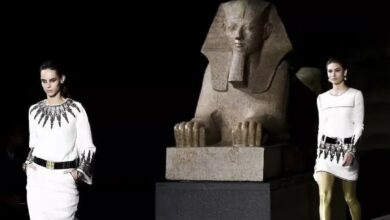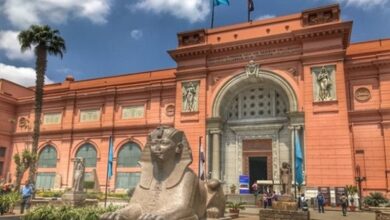“The road to Memphis and Thebes passes through Turin,” wrote the decipherer of Egyptian hieroglyphs Jean-François Champollion when he came to Turin in 1824. The Egyptian Museum of antiquities in Turin, an elegant city in the Italian northern region of Piedmont, is the second most important Egyptian museum in the world and the only one exclusively dedicated to the art and culture of ancient Egypt after the Egyptian Museum in Cairo.
Unlike the Egyptian Museum in Cairo, the collection in Turin is well organized according to a chronological and thematic principle, resulting in less confusion for visitors.
King Carlo Felice, who acquired Bernardino Drovetti’s collection of 5268 objects, founded the museum in 1824. Since then, it has been hosted in the Academy of Sciences Palace, which was designed by baroque-period architect Guarino Guarini for the Jesuit school.
The Museo Egizio (Egyptian Museum) exhibits different collections acquired over the years and archaeological finds from excavations done by the Italian archaeological mission in Egypt from 1900-1935. It currently owns 6500 objects and 26,500 pieces in its magazines.
The first object to arrive in Turin was the Isis canteen, which belonged to the Roman era and represented Isis, the goddess of fertility and wife of Osiris, who was also worshiped in western Asia, Greece and Rome.
On the first level of the museum, visitors are met with mummy-shaped statuettes representing Osiris. These statuettes were either hollow or filled with papyrus from the Book of the Dead, grains of wheat wrapped in bandages, a symbol of rebirth, or internal paintings.
A number of colored papyrus sheets from the Book of the Dead show funeral texts from the New Kingdom (1540-1070 BC) onwards. The Book of the Dead, a collection of papyrus rolls, derives from diverse religious traditions and includes hymns, prayers, instructions and rituals used as a guide to reach the afterlife. The book details the steps the deceased had to follow in order to achieve the “glorified spirit.”
The Book also depicts the moment of psychostasis, or weighing of the soul, when the deceased is judged by weighing his heart –believed to be the seat of intelligence–against a feather.
The collection on the first floor also includes different kinds of ushabti (a term that can mean “follower” or “answerer” in Ancient Egyptian), funerary statuettes usually deposited in the tombs in terracotta or wooden boxes. The mummy-shaped ushabti are meant to substitute the deceased in the afterlife by carrying out the tasks required and, according to the tradition, by answering “I am here and will come whenever you bid me.” They date back to the Middle Kingdom and onward and they were often found in the tombs of both the royal family and common people.
One noteworthy artifact of the museum is “The tomb of the unidentified,” which includes sarcophagi from a fifth dynasty tomb in Luxor. The tomb was discovered in 1911 in Gebelein by the Italian archaeologist Ernesto Schiaparelli, who was director of the museum from 1894 until 1928. The tomb, of which only two out of three rooms held sarcophagi, did not bear any inscriptions recording the name of the sarcophagi, hence its status as “unidentified.”
Finally, a few fragments that survived from the map of the gold mines of Wadi Hammamat represent an exceptional fortune, considering that ancient maps are very rare documents. The map includes information in cursive hieratic script, such as the distance between the quarry and the mine and the location of the gold deposits.
Among canopic vessels of animal and human shapes, objects belonging to the everyday life, such as toiletries, an anthropomorphic unguent jar, funeral kid, and small funerary stelae, a statuette of a pregnant hippopotamus representing taweret, protector of childbirth and family life, stands out.
An entire section is dedicated to Coptic texts, written in Greek letters, Coptic ostraca and codices. This is the period during which Christian iconographic motifs coexist with the Egyptian ones. Inheriting some of the symbols such as the ankh, Christian funeral traditions developed similar practices as the ancient Egyptian ones such as mummification.
Another section of the museum exhibits the diffusion of the ancient Egyptian art in Europe due to the cults of Isis and Serapis that enjoyed official status under the reign of Caligula. The Ptolemaic and Roman galleries are also worth visiting.
The last great addition to the Museum’s collection was the small Temple of Ellesija, which was donated by Egypt to Italy for its sustained technical and scientific support during the Nubian monument salvage campaign directed by UNESCO during the digging of Lake Nasser and the construction of the High Dam. The temple was used as a church during the Christian period as signified by the adjunct of crosses on the walls.
The statuary is complemented by soft blue lighting designed by Dante Ferretti, Oscar-winning production designer of the movie Aviator. Among the gods Ptah, Amun, and Hathor, 21 figures of the warrior goddess Sekhmet, whose lioness head is crowned by a solar disk, stand out. The pharaoh victorious over his enemies was likened to the vindictive Sekhmet.
Another room is exclusively dedicated to one of the masterpiece of the museum, which is the tomb of the architect Kha and his wife Merit, with sarcophagi and surviving finds of everyday items and clothing from ancient Egypt.
The museum, which is currently restoring its works, is part of the Foundation Museum of the Egyptian Antiquities, the Italian state’s first foray into joint management to direct a museum. Its president is journalist and writer Alain Elkann, and since 2005, its director has been Eleni Vassilika.




